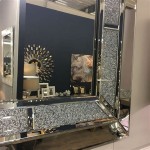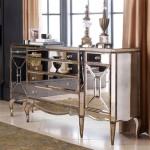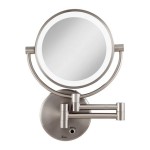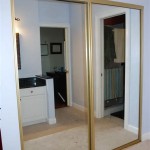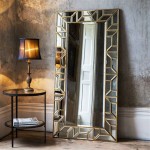Vintage Mercury Glass Mirrors: A Reflection of History and Style
Vintage mercury glass mirrors hold a unique allure, captivating with their antique charm and subtle imperfections. Unlike modern mirrors, which utilize a silvering process, these antique pieces employ mercury to create their reflective surface, resulting in a distinctive aesthetic that evokes a sense of history and elegance.
The process of creating mercury glass mirrors, also known as verre églomisé, dates back centuries. Artisans would carefully apply a thin layer of tin foil to the back of a glass pane. Mercury was then poured over the tin foil, creating an amalgam that adhered to the glass. Once the excess mercury was removed, a protective backing was applied, completing the process. This meticulous technique resulted in a mirror with a slightly mottled, aged appearance, often exhibiting subtle speckling and discoloration, characteristics highly valued by collectors today.
The earliest examples of mercury glass mirrors can be traced back to the 16th century in Venice, Italy. Venetian glassmakers, renowned for their artistry and innovation, perfected the technique, creating exquisite mirrors that became highly sought-after luxury items. The secrets of mercury glass production were closely guarded, contributing to the exclusivity and high value of these mirrors.
From Venice, the craft of mercury glass mirror making spread throughout Europe. French artisans, in particular, embraced the technique, adapting and refining it to create their own unique styles. During the 18th and 19th centuries, mercury glass mirrors became integral components of opulent interiors, adorning grand homes and palaces.
Distinguishing a genuine vintage mercury glass mirror from a modern reproduction requires careful observation. Authentic antique mirrors will exhibit signs of age, including subtle foxing, or age spots, on the glass surface. The reflective surface may also appear slightly hazy or distorted compared to the crisp clarity of modern mirrors. Furthermore, the backing of a genuine antique mirror will often show signs of wear and tear, reflecting the passage of time.
The backs of these mirrors are often as intriguing as the reflective surface. Early examples may feature hand-painted designs or intricate paper backing. Later examples might utilize wood or gesso as a protective backing. Examining the back of a mercury glass mirror can offer valuable clues about its age and origin.
The size and shape of vintage mercury glass mirrors can vary considerably. Small hand mirrors, designed for personal use, are highly collectible. Larger wall mirrors, often elaborately framed, served as decorative centerpieces in grand interiors. Convex mirrors, with their characteristic bulging reflective surface, were also popular, offering a wider field of view.
Caring for a vintage mercury glass mirror requires a gentle approach. Avoid harsh cleaning chemicals, which can damage the delicate mercury backing. A soft, damp cloth is usually sufficient for cleaning the glass surface. If the backing is damaged, it is advisable to consult a professional conservator to ensure proper restoration.
The resurgence of interest in vintage and antique décor has contributed to the increasing popularity of mercury glass mirrors. Their timeless appeal and unique aesthetic qualities make them highly desirable additions to a variety of interior styles, from traditional to eclectic.
Incorporating a vintage mercury glass mirror into a modern interior can add a touch of history and character. These mirrors can serve as focal points, reflecting light and creating a sense of depth within a room. Their aged patina and subtle imperfections contribute to their unique charm, making each piece a one-of-a-kind work of art.
The value of a vintage mercury glass mirror is determined by several factors, including age, size, condition, and provenance. Rare and exceptional examples can command significant prices at auction and antique markets. However, even more common examples can be valuable additions to a collection, offering a tangible connection to the past.
The appeal of vintage mercury glass mirrors extends beyond their decorative value. They serve as a testament to the artistry and craftsmanship of past generations. These mirrors reflect not only our own image but also the history and techniques that brought them into being.
When considering purchasing a vintage mercury glass mirror, it is important to research and understand the characteristics of genuine antique pieces. Reputable antique dealers and auction houses can provide valuable guidance and authentication services.
The subtle imperfections and aged patina of vintage mercury glass mirrors are what truly set them apart. These characteristics are not flaws, but rather testaments to the passage of time and the unique history of each piece. They offer a glimpse into the past, reflecting the artistry and craftsmanship of a bygone era.

Antique Mercury Glass Mirror 19th Century For At Pamono

Mercury Mirror

Through The Looking Glass Ix Mercury Mirror Old Mirrors Shabby

Antique Mercury Glass Mirror 19th Century Chairish

19th Century Mirror In Mercury Glass With Carved And Gilt Wood Frame For At Pamono

French Antique Vintage Mirror Beautiful Unique Glass Quick Ship

Diy Mercury Glass Gilded Mirror Made From Old Photo Frames

Large Victorian Mercury Glass Mirror The Vintage Wall

Original Mercury Glass Mirror Sublime 18th Century Antique New Zealand

Diy Mercury Glass Gilded Mirror Made From Old Photo Frames

